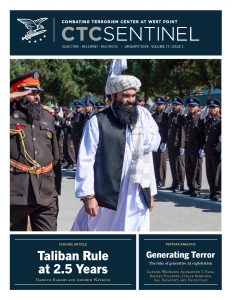From the Editor
In the feature article, Haroun Rahimi and Andrew Watkins assess Taliban rule two and a half years into their renewed control of Afghanistan. They write: “Since their 2021 takeover, the Taliban have consolidated control over an impoverished and austere postwar Afghanistan. Since their victory, the Taliban’s emir has reasserted his status as a ‘supreme leader’ and oriented domestic policy in favor of highly conservative constituencies—which has revealed deep differences among their leadership of visions for the future of the Afghan state and society and how authority is divided among themselves. Yet, the Taliban have persistently prioritized the cohesion of their movement and governing apparatus. This trajectory has earned condemnation from Western states and prompted caution in the entire world’s engagement, which has in turn fueled Taliban motivations to reject foreign demands. After two and a half years of rule, the Taliban’s domestic agenda has become intertwined with their foreign relations impasse.”
Gabriel Weimann, Alexander Pack, Rachel Sulciner, Joelle Scheinin, Gal Rapaport, and David Diaz write that “with the arrival and rapid adoption of sophisticated deep-learning models such as ChatGPT, there is growing concern that terrorists and violent extremists could use these tools to enhance their operations online and in the real world. Large language models have the potential to enable terrorists to learn, plan, and propagate their activities with greater efficiency, accuracy, and impact than ever before.” The authors offer “an early exploration of how these large language models could be exploited by terrorists or other violent extremists … to support their efforts in training, conducting operational planning, and developing propaganda.”
Georgia Gilroy decodes al-Shabaab’s social media strategy, outlining the “controlled, adaptive, and coordinated approach the terrorist group takes to its online behavior.” She writes that the group’s “continued resilience, even in the face of mounting counterinsurgency efforts, is underpinned by its sophisticated communications architecture.”
Christian Jokinen assesses whether left-wing terrorism is making a comeback in Germany in a case study of the violent left-wing Engel – Guntermann network. He writes that “the recent concerning trend among German left-wing extremists is toward greater violence and transnationalism.”
Paul Cruickshank, Editor in Chief
 Skip to content
Skip to content

